
Station Name: COLDSTREAM[Source: Alan Young]
Coldstream Station Gallery 1: c1910 - Early 1950s  Coldstream station staff line up for the photographer in front of the stationmaster’s house and office range on the up (Berwick-bound) platform, c1910. Although handsome, the buildings in uncoursed sandstone do not possess the dignity and opulence of those on the East Coast main line designed by the same architects, John and Benjamin Green. A point of architectural interest is the bay window (to provide the stationmaster with a good view of the platforms) beneath the corbelled-out gable and overhanging roof. The stations on this line were fitted with smart lanterns, seen here fixed to the buildings. The coiled serpent bench beyond the building was a feature often seen at North Eastern Railway stations.
Copyright photo from John Alsop collection  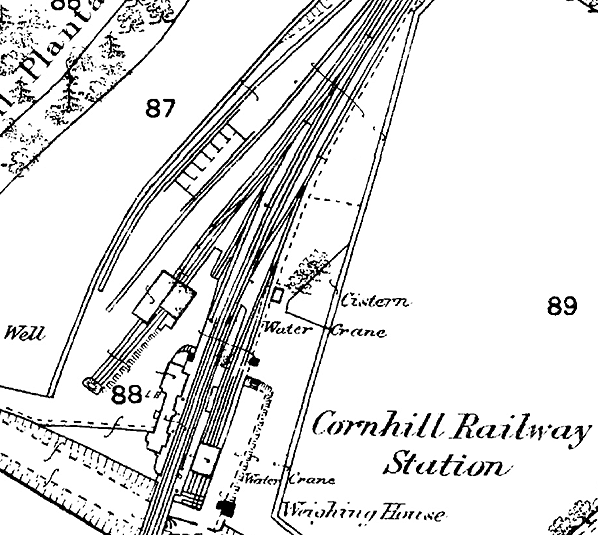
1883 1:2,500 OS map. Although shown as ‘Cornhill’ the station had been renamed ‘Coldstream’ ten years earlier. This map pre-dates by four years the opening of the Alnwick & Cornhill Railway which elevated Coldstream to the status of a junction. In a sparsely populated area the adjacent village of Cornhill and the small town of Coldstream (over a mile distant on the Scottish side of the River Tweed) justified the provision of substantial buildings in the passenger station and generous goods facilities. The main building is on the west (up) platform with a modest waiting shed on the opposite platform. Behind the down platform two sidings serve the coal depot with its ‘Weighing House’, and on the up side are several sidings, a two-road goods shed and livestock pens.

1898 1: 2,500 OS map. The station has become a junction following the opening of the Alnwick & Cornhill Railway which diverges from the Kelso line immediately south of the road underbridge and runs alongside the original line for about 500yd. The station’s name has been changed to ‘Coldstream’. A footbridge has been added as has a signal box immediately north of it on the up platform. A siding with a turntable has been added on the down side beyond the coal depot. A weigh office (‘W.M.’ – weighing machine) is shown to the west of the passenger station and the earlier ‘Weighing House’ is no longer named. The construction of an auction mart immediately west of the station and adjacent to the cattle dock (not named) is the most conspicuous change in the vicinity of the station. To the north of the mart is the tantalisingly-named ‘Implement Works’. A row of three railway cottages (named ‘Station Cottages’ on later maps) has been built very close to the sidings on the down side of the tracks.
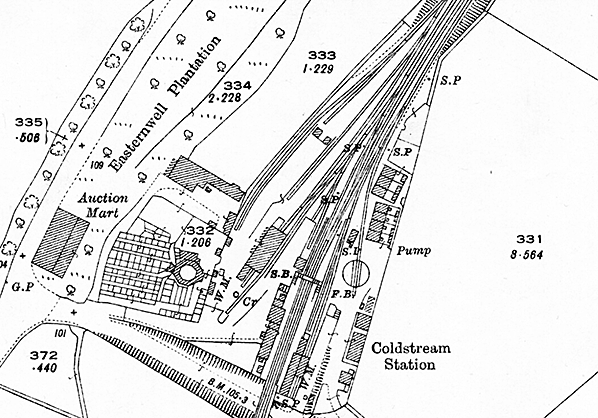 1924 1:2,500 OS map. Coldstream station is seen here probably at its zenith, with a terrace of four railway cottages joining the three already there. A crane is now shown close to the weigh office, west of the passenger station, and a further weigh office is indicated for the sidings east of the station. Apart from the railway cottages the presence of the station seems not to have encouraged the development of housing in its vicinity.

Looking south from the footbridge at Coldstream station c1930. The buildings on both platforms are seen to advantage from this viewpoint, the stationmaster’s two-storey house and offices being on the up (right, Berwick-bound) platform. Beyond the bridge is the junction where the Alnwick Branch (left) leaves the Kelso route, although the lines run alongside each other for some distance before diverging.
Copyright photo from Stations UK 
Looking north-east from the up platform of Coldstream station in May 1937. The stationmaster’s house, offices and waiting rooms are behind the photographer. The footbridge is a typical late nineteenth century NER design. Beyond it is the station’s water tank carried on a tall stone plinth. Post-mounted oil casement lamps adorn the down platform. In the distance are the two terraces of railwaymen’s cottages constructed between 1882 and 1897. The locomotive in the distance is too far away for positive identification but has the appearance of a J25 0-6-0 about it; it lacks a smokebox numberplate but still carries its number on the bufferbeam as was LNER practice. All signals visible are still lower quadrant wooden arms types (presumably of NER origin); during the 1950s most if not all at Coldstream were to be replaced by upper quadrant, metal-arm types.
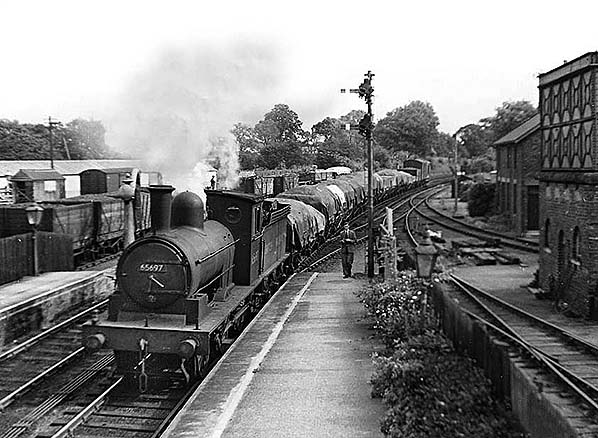
On 18 July 1951 a down goods train is entering Coldstream station. The photographer is looking north from the footbridge. To the right, beyond the siding, is the water tank; a further siding passes in front of the terrace of railwaymen’s cottages. The locomotive is Worsdell-designed J25 0-6-0 No.65697, built by the NER at Gateshead in May 1900; she would be withdrawn from 54C, Borough Gardens shed, in November 1958 and cut up at Darlington Works, North Road in May 1959.
Photo by ER Morten 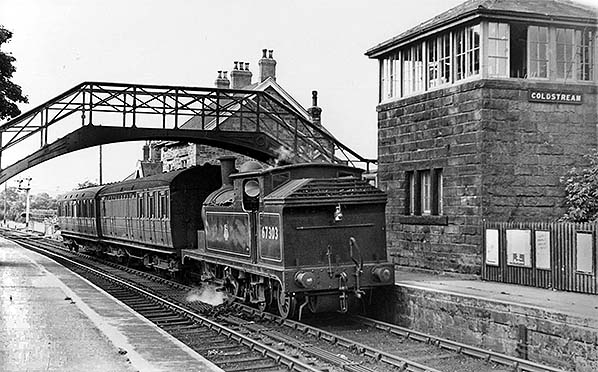 In July 1951 a two-coach local passenger train stands at the up platform of Coldstream station. The loco hauling it is Worsdell-designed G5 0-4-4T No.67303, built in October 1900 at the NER Darlington works. She was withdrawn from 52D, Tweedmouth shed in February 1953. The signal box and footbridge were installed by the North Eastern Railway in 1887 when the station became a junction with the opening of the line to Alnwick.
Photo from John Mann collection 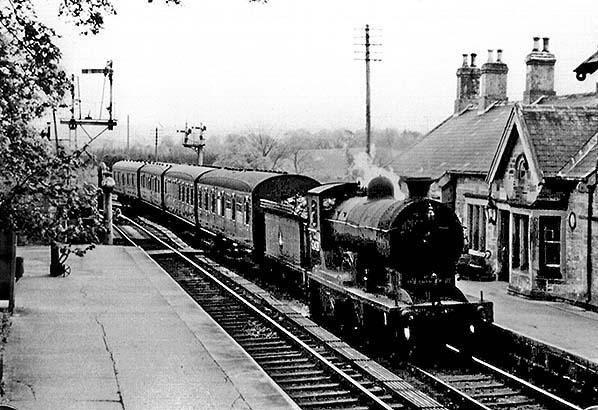
Coldstream station is seen in the early or mid 1950s, looking south-west from the footbridge. The office and waiting room range of the station can be seen to the right on the up platform. The four-coach train represents lavish provision on a line where two coaches are the norm. The locomotive is Class D30 No.62428 ‘The Talisman’ built in 1914 and based at 64G, Hawick shed, from which she would be withdrawn in December 1958.
Photo from Railways of Berwick and the Eastern Borders Facebook Group
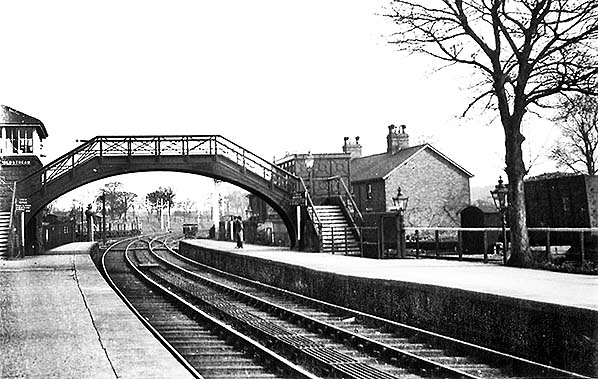
This view of the northern end of Coldstream station includes various North Eastern Railway features, such as the signal box and footbridge, dating from the station’s elevation to a junction in 1887, the railway cottages built between 1882 and 1897, and post-mounted oil lanterns. The goods yard is accommodating a rake of wagons. The dark paint on the signs suggests that LNER livery is still on display and that the photo was taken in, or before, the early 1950s.
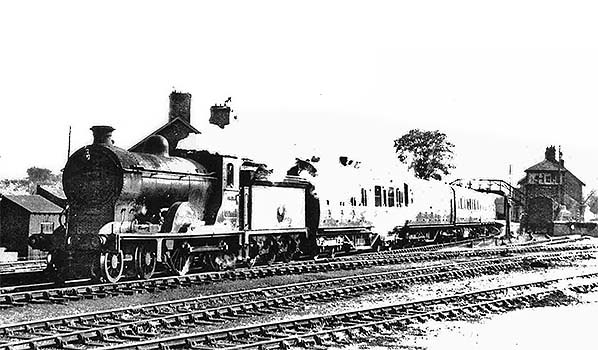 Looking south-east across the goods sidings towards Coldstream station in the early 1950s. The signal box, footbridge and gable of the stationmaster’s house are visible and one of the terraces of railwaymen’s cottages is seen beyond the locomotive. A local passenger train is drawing out from the station on its way to Tweedmouth and Berwick, hauled by an ex NBR K Class, LNER/BR Class D34 4-4-0 or 'Glen' class. As this implies, all of the class were named after Glens and the names were painted on the splashers. Although it is difficult to discern, the loco is in BR livery and carries the early BTC/BR 'Cycling Lion' logo on the tender. Identification of the loco is offered tentatively: a couple of digits of the smokebox numberplate and cabside number, a 2 and a 9, can be seen on close inspection, and the last letter of the name appears to be a 'G'. Only one of the Glens fits the bill, this being No.62490 'Glen Fintaig'. She spent her BR years mainly at St Margarets shed but with a brief spell at Hawick. Withdrawal came in February 1959. The first carriage is a Thompson Non Corridor Lavatory Composite and the second a Gresley steel-panelled Five Compartment Brake Third. This combination appears in other pictures so it was possibly a two-car set dedicated to these services and bolstered with extra coaches as necessary. One of the Glens, 'Glen Douglas', has survived into preservation. Looking south-east across the goods sidings towards Coldstream station in the early 1950s. The signal box, footbridge and gable of the stationmaster’s house are visible and one of the terraces of railwaymen’s cottages is seen beyond the locomotive. A local passenger train is drawing out from the station on its way to Tweedmouth and Berwick, hauled by an ex NBR K Class, LNER/BR Class D34 4-4-0 or 'Glen' class. As this implies, all of the class were named after Glens and the names were painted on the splashers. Although it is difficult to discern, the loco is in BR livery and carries the early BTC/BR 'Cycling Lion' logo on the tender. Identification of the loco is offered tentatively: a couple of digits of the smokebox numberplate and cabside number, a 2 and a 9, can be seen on close inspection, and the last letter of the name appears to be a 'G'. Only one of the Glens fits the bill, this being No.62490 'Glen Fintaig'. She spent her BR years mainly at St Margarets shed but with a brief spell at Hawick. Withdrawal came in February 1959. The first carriage is a Thompson Non Corridor Lavatory Composite and the second a Gresley steel-panelled Five Compartment Brake Third. This combination appears in other pictures so it was possibly a two-car set dedicated to these services and bolstered with extra coaches as necessary. One of the Glens, 'Glen Douglas', has survived into preservation.Photo from Roy Lambeth collection Click here for Coldstream Station Gallery 2:
|
 Originally just a ‘wayside’ station, Coldstream became a junction in 1887 when the lengthy branch to Alnwick opened. Although Coldstream station had carried this name for 14 years the new line was known as the ‘Alnwick & Cornhill’ branch. John Addyman and the late John Mallon’s detailed and authoritative book about the line, The Alnwick & Cornhill Railway (NERA, 2007) is highly recommended. The new line carried a special train in early May 1887 ‘conveying stationmasters, porters, signalmen, clerks and others with their wives and families to the places allotted to them’ and a goods service of one train a day in each direction started between Coldstream and Wooperton on 9 May. Regular passenger services began on 5 September 1887.
Originally just a ‘wayside’ station, Coldstream became a junction in 1887 when the lengthy branch to Alnwick opened. Although Coldstream station had carried this name for 14 years the new line was known as the ‘Alnwick & Cornhill’ branch. John Addyman and the late John Mallon’s detailed and authoritative book about the line, The Alnwick & Cornhill Railway (NERA, 2007) is highly recommended. The new line carried a special train in early May 1887 ‘conveying stationmasters, porters, signalmen, clerks and others with their wives and families to the places allotted to them’ and a goods service of one train a day in each direction started between Coldstream and Wooperton on 9 May. Regular passenger services began on 5 September 1887. The Railway Clearing House Handbook for 1904 shows that Coldstream station was able to handle a wide range of goods traffic and was equipped with a 1-ton yard crane. The goods yard had been extended after the opening of the Alnwick branch. The surrounding area is productive arable and pastoral farmland and this was reflected in the principal goods dispatched from the station in 1913: barley (2,285 tons), potatoes (697 tons), oats (418 tons), and 1,090 wagons of livestock. The station’s passenger traffic was heavier than at the other intermediate stations between Tweedmouth and Kelso, reflecting its more populous catchment of 3,259 (in 1911) including the adjacent village of Cornhill and small town of Coldstream as well as its role as a junction. The station issued 22,341 tickets in 1911: in comparison its neighbouring stations booked far fewer tickets -Sunilaws 2,680, Twizell 3,614, and Mindrum 4,234.
The Railway Clearing House Handbook for 1904 shows that Coldstream station was able to handle a wide range of goods traffic and was equipped with a 1-ton yard crane. The goods yard had been extended after the opening of the Alnwick branch. The surrounding area is productive arable and pastoral farmland and this was reflected in the principal goods dispatched from the station in 1913: barley (2,285 tons), potatoes (697 tons), oats (418 tons), and 1,090 wagons of livestock. The station’s passenger traffic was heavier than at the other intermediate stations between Tweedmouth and Kelso, reflecting its more populous catchment of 3,259 (in 1911) including the adjacent village of Cornhill and small town of Coldstream as well as its role as a junction. The station issued 22,341 tickets in 1911: in comparison its neighbouring stations booked far fewer tickets -Sunilaws 2,680, Twizell 3,614, and Mindrum 4,234.
 Stationmasters at Coldstream during the LNER era were Mr Isaac Nixon until May 1929, followed by Mr J W Young from June 1929 until December 1933, then Mr R Redpath whose tenure lasted until February 1939. After a short interregnum Mr J Clarke was appointed stationmaster in June 1939. He also supervised Mindrum station on the Alnwick line; it is possible that his predecessor acquired this responsibility after Mindrum closed to passengers in 1930 and thereafter handled only goods and parcels traffic.
Stationmasters at Coldstream during the LNER era were Mr Isaac Nixon until May 1929, followed by Mr J W Young from June 1929 until December 1933, then Mr R Redpath whose tenure lasted until February 1939. After a short interregnum Mr J Clarke was appointed stationmaster in June 1939. He also supervised Mindrum station on the Alnwick line; it is possible that his predecessor acquired this responsibility after Mindrum closed to passengers in 1930 and thereafter handled only goods and parcels traffic. In June 1955 the service was the same except that the 9.54am and 4.03pm departures were retimed on Saturday only. The following month, the service was reduced to two trains per day each way (weekdays only) and five of the seven intermediate stations between Tweedmouth and Kelso were closed. Coldstream station remained open and staffed, undoubtedly generating more revenue from its goods and coal traffic than from its handful of passengers. The station retained its essentially Victorian appearance, and modernization was restricted to repainting the LNER nameboards in BR(NE) tangerine. The steam-operated service of two return train trips continued until 1964 and is shown below in the winter 1962/63 timetable:
In June 1955 the service was the same except that the 9.54am and 4.03pm departures were retimed on Saturday only. The following month, the service was reduced to two trains per day each way (weekdays only) and five of the seven intermediate stations between Tweedmouth and Kelso were closed. Coldstream station remained open and staffed, undoubtedly generating more revenue from its goods and coal traffic than from its handful of passengers. The station retained its essentially Victorian appearance, and modernization was restricted to repainting the LNER nameboards in BR(NE) tangerine. The steam-operated service of two return train trips continued until 1964 and is shown below in the winter 1962/63 timetable:
 Home Page
Home Page